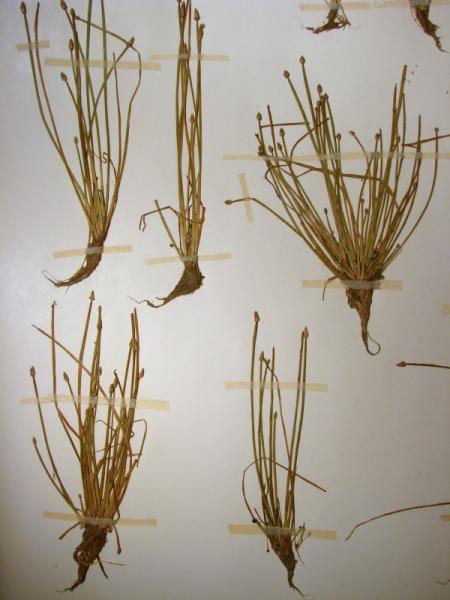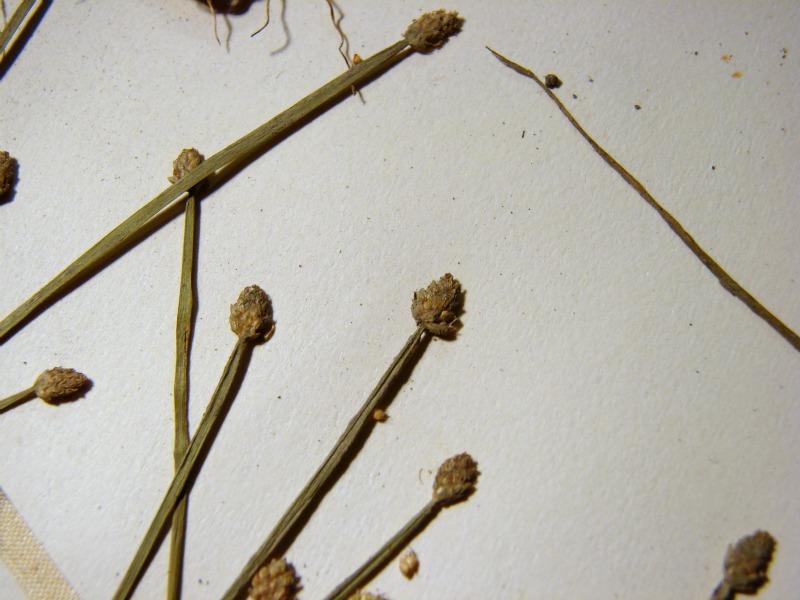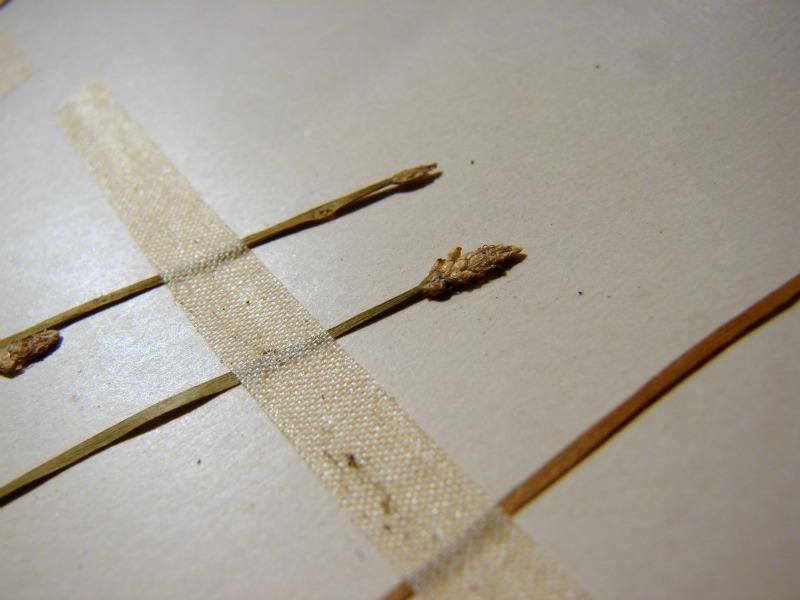Intertidal Spike Rush
Eleocharis aestuum Hines & A. Haines
- Class
- Monocotyledoneae (Monocots)
- Family
- Cyperaceae (Sedge Family)
- State Protection
- Endangered
Listed as Endangered by New York State: in imminent danger of extirpation in New York. For animals, taking, importation, transportation, or possession is prohibited, except under license or permit. For plants, removal or damage without the consent of the landowner is prohibited.
- Federal Protection
- Not Listed
- State Conservation Status Rank
- S1
Critically Imperiled in New York - Especially vulnerable to disappearing from New York due to extreme rarity or other factors; typically 5 or fewer populations or locations in New York, very few individuals, very restricted range, very few remaining acres (or miles of stream), and/or very steep declines.
- Global Conservation Status Rank
- G3
Vulnerable globally - At moderate risk of extinction due to rarity or other factors; typically 80 or fewer populations or locations in the world, few individuals, restricted range, few remaining acres (or miles of stream), and/or recent and widespread declines.
Summary
Did you know?
The species was noted as different from the closely related species Eleocharis diandra and Eleocharis ovata in 1975 but it was not formally assigned its present scientific name until the year 2000. It was referred to for many years by the unpublished name Eleocharis pallidostachys. It is globally rare because the only recent records are from the Androscoggin and Kennebec rivers in Maine and the Hudson River in New York. Its species name aestuum means "tidal" since it is found in the freshwater tidal areas of these three rivers.
State Ranking Justification
There are two existing populations, one large and one small. There are 10 historical populations from the Hudson River area, mostly from the 1930s when intensive surveys were done.
Short-term Trends
The short-term trend is unclear because no recent surveys have been performed to see how the plants are doing.
Long-term Trends
Not enough recent surveys have been done at the historical occurrences of this species to determine its long-term trend. There are many historical records from the Hudson River surveys of the 1930s and they need to be checked again. The small size of this plant, its difficult technical characters, and its habitat in tidal areas will make this determination a long process.
Conservation and Management
Threats
There may be a threat from phragmites or purple loosestrife in tidal marshes but the full extent of threats is unknown.
Conservation Strategies and Management Practices
It is unclear which specific management techniques are necessary to preserve these populations. The open shoreline habitat needs to be maintained by preventing establishment of invasive species and direct human destruction.
Research Needs
Research is needed on habitat preference and best management practices to protect current populations. All of the historical occurrences need to be checked for existing populations.
Habitat
Habitat
In New York, tidal spikerush has been found at the edge of a tidal creek, growing on mudflats, sometimes interspersed with freshwater tidal marsh (New York Natural Heritage Program 2007). Freshwater tidal shores (FNA 2003).
Associated Ecological Communities
- Freshwater intertidal mudflats
(guide)
A sparsely vegetated community characterized by low rosette-leaved aquatics. This community occurs on exposed intertidal mudflats where the water is fresh (salinity less than 0.5 ppt). This community is best developed where mudflats are nearly level so that broad expanses are exposed at low tide. The plants are completely submerged in 0.9 to 1.2 m (3 to 4 ft) of water at high tide and they are usually coated with mud.
- Freshwater tidal marsh
(guide)
A marsh community that occurs in shallow bays, shoals, and at the mouth of tributaries of large tidal river systems, where the water is usually fresh (salinity less than 0.5 ppt), and less than 2 m (6 ft) deep at high tide. Typically there are two zones in a freshwater tidal marsh: a low-elevation area dominated by short, broadleaf emergents bordering mudflats or open water, and a slightly higher-elevation area dominated by tall grass-like plants.
Associated Species
- Bidens bidentoides (estuary beggar-ticks)
- Bidens cernua (nodding beggar-ticks)
- Cyperus bipartitus (shining flat sedge)
- Helenium autumnale (common sneezeweed)
- Heteranthera dubia (water star-grass)
- Juncus acuminatus (sharp-fruited rush)
- Lobelia cardinalis (cardinal flower)
- Ludwigia palustris (water-purslane)
- Lythrum salicaria (purple loosestrife)
- Mimulus ringens (Allegheny monkey-flower)
- Nuphar
- Peltandra virginica (green arrow-arum, tuckahoe)
- Persicaria hydropiperoides (mild water-pepper)
- Pilea fontana (black-fruited clearweed)
- Pontederia cordata (pickerelweed)
- Rumex
- Sagittaria graminea
- Sagittaria latifolia (common arrowhead)
- Sagittaria rigida (sessile-fruited arrowhead)
- Sagittaria subulata (awl-leaved arrowhead)
- Schoenoplectus pungens
- Zizania aquatica
Range
New York State Distribution
In New York this species has only been found in Ulster, Dutchess, Greene, and Columbia Counties, along the freshwater tidal portion of the Hudson River.
Global Distribution
Tidal spikerush has been found in tidal rivers from Maine to Delaware.
Identification Comments
General Description
Spikerushes consist of a simple stem (the leaves bladeless and inconspicuous), with the infloresence consisting of a solitary, many-scaled spikelet at the top of the stem. The perianth (sepals and petals), if present, is reduced to (usually 3 or 6) bristles. The base of the style is expanded into a tubercle, and is usually persistent on the fruit (achenes). Tidal spikerush may be up to 30 cm tall, the stems often spreading or declining. The spikelets are ellipsoid to ovoid and 3-10 mm long, and the scales colorless to pale brownish, except for a green midrib. There are 2-4 perianth bristles, or sometimes none, the tubercles are deltoid, and the achenes .75 to 1 mm long.
Best Life Stage for Proper Identification
Fruiting specimens are necessary for identification.
Similar Species
Eleocharis aestuum is most similar to E. diandra and E. ovata. E. diandra differs from E. aestuum in its lower tubercles, brown floral scales, and absence of perianth bristles. E. ovata differs by having more (5-7) and longer perianth bristles (exceeding the combined length of the achene and tubercle), and narrow but taller (.3 to .5 mm high) tubercles, and is only rarely found in the tidal zone (Haines 2003, Haines 2001, FNA 2003).
Best Time to See
Tidal Spikerush may bear fruit from late August to early October.
- Fruiting
The time of year you would expect to find Intertidal Spike Rush fruiting in New York.
Intertidal Spike Rush Images
Taxonomy
Intertidal Spike Rush
Eleocharis aestuum Hines & A. Haines
- Kingdom Plantae
- Phylum Anthophyta
- Class Monocotyledoneae
(Monocots)
- Order Cyperales
- Family Cyperaceae (Sedge Family)
- Order Cyperales
- Class Monocotyledoneae
(Monocots)
- Phylum Anthophyta
Additional Common Names
- Tidal Spike Rush
Additional Resources
References
Flora of North America Editorial Committee. 2002. Flora of North America, North of Mexico. Volume 23. Magnoliophyta: Commelinidae (in part): Cyperaceae. Oxford University Press, New York. 608 pp.
Gleason, Henry A. and A. Cronquist. 1991. Manual of Vascular Plants of Northeastern United States and Adjacent Canada. The New York Botanical Garden, Bronx, New York. 910 pp.
Haines, Arthur. 2001. Eleocharis aestuum (Cyperaceae), a new tidal river shore spikesedge of the eastern United States. Novon 11(1):45-49.
Haines, Arthur. 2003. Eleocharis aestuum (Cyperaceae) in New York. NY Flora Association Newsletter. Vol 14(1): 4-6. March 2003.
Holmgren, Noel. 1998. The Illustrated Companion to Gleason and Cronquist's Manual. Illustrations of the Vascular Plants of Northeastern United States and Adjacent Canada. The New York Botanical Garden, Bronx, New York.
New York Natural Heritage Program. 2010. Biotics database. New York Natural Heritage Program. New York State Department of Environmental Conservation. Albany, NY.
New York Natural Heritage Program. 2024. New York Natural Heritage Program Databases. Albany, NY.
Weldy, T. and D. Werier. 2010. New York flora atlas. [S.M. Landry, K.N. Campbell, and L.D. Mabe (original application development), Florida Center for Community Design and Research http://www.fccdr.usf.edu/. University of South Florida http://www.usf.edu/]. New York Flora Association http://newyork.plantatlas.usf.edu/, Albany, New York
Weldy, Troy W. and David Werier. 2005. New York Flora Atlas. [S.M. Landry, K.N. Campbell, and L.D. Mabe (original application development), Florida Center for Community Design and Research. University of South Florida]. New York Flora Association, Albany, NY. Available on the web at (http://newyork.plantatlas.usf.edu/).
Links
About This Guide
Information for this guide was last updated on: April 18, 2019
Please cite this page as:
New York Natural Heritage Program. 2024.
Online Conservation Guide for
Eleocharis aestuum.
Available from: https://guides.nynhp.org/tidal-spike-rush/.
Accessed July 26, 2024.



